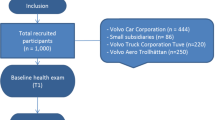Abstract
Hostility as measured by the Cook-Medley Hostility (HO) Scale on the Minnesota Multiphasic Personality Inventory has been suggested as a risk factor for coronary heart disease (CHD) and total mortality. This study tested the HO-CHD hypothesis in a sample of 1399 men who entered the University of Minnesota in 1953 and, as part of freshman orientation, completed the MMPI. Current health status was ascertained for 94% of the sample through telephone interviews 33 years later. Higher HO scores did not predict CHD mortality, CHD morbidity, or total mortality either before or after adjustment for baseline risk factors. Among the plausible explanations for these results are that (1) hostility is not a risk factor in all populations, (2) the HO scale at age 19 does not assess a stable psychological characteristic, or (3) the HO scale is not an adequate measure of hostility.
Similar content being viewed by others
References
Barefoot, J. C., Dahlstrom, W. G., and Williams, R. B. (1983). Hostility, CHD incidence, and total mortality: A 25-year follow-up study of 255 physicians.Psychosom. Med. 45: 59–63.
Barefoot, J. C., Williams, R. B., Dahlstrom, W. G., and Dodge, K. A. (1987). Predicting mortality from scores on the Cook-Medley Scale: A follow-up study of 118 lawyers.Psychosom. Med. 49: 210.
Barefoot, J. C., Dodge, K. A., Peterson, B. L., Dahlstrom, W. G., and Williams, R. B. (1988). The Cook-Medley hostility scale: Item content and ability to predict survival (unpublished manuscript).
Chesney, M. A., and Rosenman, R. H. (1985).Anger and Hostility in Cardiovascular and Behavioral Disorders, Hemisphere, Washington, D.C.
Cook, W. W., and Medley, D. M. (1954). Proposed hostility and pharisaic-virtue scales for the MMPI.J. Appl. Psychol. 38: 414–418.
Colligan, R. C., and Offord, K. P. (1988). The risky use of the MMPI hostility scale in assessing risk for coronary heart disease.Psychomatics, 29: 188–196.
Costa, P. T. (1986). Is neuroticism a risk factor for CAD? Is Type A measure of neuroticism? In Schmidt, T., Dembroski, T., and Blumchen, G. (ed.),Biological and Psychological Factors in Cardiovascular Disease, Springer-Verlag, New York.
Costa, P. T., Zonderman, A. B., McCrae, R. R., and Williams, R. B. (1986). Cynicism and paranoid alienation in the Cook and Medley HO Scale.Psychosom. Med. 48: 283–285.
Costa, P. T., Zonderman, A. B., McCrae, R. R., and Williams, R. B. (1985). Content and comprehensiveness in the MMPI: An item factor analysis in a normal adult sample.J. Personal. Soc. Psychol. 48: 925–933.
Dahlstrom, W. G., Welsh, G. S., and Dahlstrom, L. E. (1975).An MMPI Handbook. Vol. II. Research Applications, University of Minnesota, Minneapolis.
Dembroski, T. M., MacDougall, J. M., Williams, R. B., Hanley, T. L., and Blumenthal, J. A. (1985). Components of Type A, hostility, and anger-in: Relationship to angiographic findings.Psychosom. Med. 47: 219–233.
Feldman, K. A., and Newcomb, T. M. (1973).The Impact of College on Students, Vol. I, Jossey-Bass, San Francisco.
Fleiss, J. L. (1981).Statistical Methods for Rates and Proportions, John Wiley & Sons, New York.
Gillum, R., Leon, G. R., Kamp, J., and Becerra-Aldama, J. (1980). Prediction of cardiovascular and other disease onset and mortality from 30-year longitudinal MMPI data.J. Consult. Clin. Psychol. 48: 405–506.
Graham, J. (1987).The MMPI: A Practical Guide, Oxford University Press, New York.
Jenkins, C. D., Rosenman, R. H., and Friedman, M. (1966). Components of the coronary-prone behavior pattern: Their relation to silent myocardial infraction and blood lipids.J. Chron. Dis. 19: 599–609.
Johnson, J. H., Butcher, J. N., Null, C., and Johnson, K. N. (1984). Replicated item level factor analysis of the full MMPI.J. Personal. Soc. Psychol. 47: 105–114.
Kleinbaum, D. G., Kupper, L. L., and Morgenstern, H. (1982).Epidemiological Methods. Wadsworth, Belmont, Calif.
Leon, G. R., Finn, S. E., Murray, D., and Bailey, J. M. (1988). The inability to predict cardiovascular disease from hostility scores or MMPI items related to Type A behavior.J. Consult. Clin. Psychol. 56: 597–600.
MacDougall, J. M., Dembroski, T. M., Dimsdale, J. E., and Hackett, T. P. (1985). Components of Type A, hostility, and anger-in: further relationship to angiographic findings.Health Psychol. 4: 137–152.
Matthews, K. A., Glass, D. C., Rosenman, R. H., and Bortner, R. W. (1977). Competitive drive, pattern A, and coronary heart disease: A further analysis of some data from the Western Collaborative Group Study.J. Chron. Dis. 30: 489–498.
McCranie, E. W., Watkins, L. O., Brandsma, J. M., and Sisson, B. D. (1986). Hostility, coronary heart disease (CHD) incidence, and total mortality: Lack of an association in a 25-year follow-up study of 478 physicians.J. Behav. Med. 9: 119–125.
Meehl, P. E., and Rosen, A. (1955). Antecedent probability and the efficiency of psychometric signs, patterns, or cutting scores.Psychol. Bull. 52: 194–216.
Shekelle, R. B., Gale, M., Ostfeld, A. M., and Oglesby, P. (1983). Hostility, risk of coronary heart disease, and mortality.Psychosom. Med. 45: 109–114.
Smith, T. W., and Frohm, K. D. (1985). What's so unhealthy about hostility? Construct validity and psychosocial correlates of the Cook and Medley HO Scale.Health Psychol. 4: 503–520.
Williams, R. B., Haney, T. L., Lee, K. L., Kong, Y., Blumenthal, J. A., and Whalen, R. E. (1980). Type A behavior, hostility, and coronary atherosclerosis.Psychosom. Med. 42: 539–549.
Author information
Authors and Affiliations
Additional information
This research was supported by a University of Minnesota, School of Public Health, Biomedical Research Support Grant (2S07-RR05448) and the National Heart, Lung, and Blood Institute (2T32-HL07328).
Rights and permissions
About this article
Cite this article
Hearn, M.D., Murray, D.M. & Luepker, R.V. Hostility, coronary heart disease, and total mortality: A 33-year follow-up study of university students. J Behav Med 12, 105–121 (1989). https://doi.org/10.1007/BF00846545
Accepted:
Issue Date:
DOI: https://doi.org/10.1007/BF00846545




